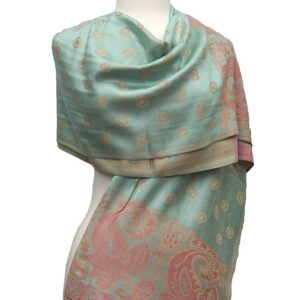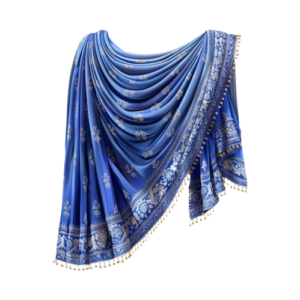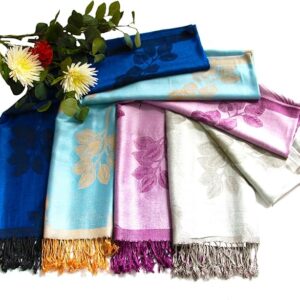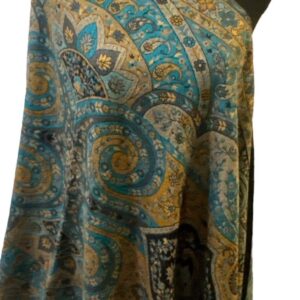In a world where trends come and go, there are some timeless treasures that stand apart, not just for their beauty but for the depth of their history and craftsmanship. One such treasure is the pashmina—a luxurious fabric with a story that stretches across centuries and continents. Let’s take a journey through the rich history of pashminas, exploring their origins, cultural significance, and rise to global fashion fame.
 luxurious feel and exquisite craftsmanship. The shawls became highly coveted items, symbolizing sophistication and elegance.
In the 19th and early 20th centuries, the pashmina saw a renaissance in the fashion world. Designers and celebrities alike embraced the fabric, cementing its status as a global fashion icon. From the runways of Paris to the streets of New York, pashminas have become synonymous with luxury and style.
Today, pashminas are not only celebrated for their elegance but also for their versatility. They are worn as shawls, wraps, and scarves, and they come in a variety of styles and designs, ranging from classic to contemporary. This adaptability ensures that pashminas continue to appeal to diverse tastes and fashion sensibilities.
Sustaining Tradition And Embracing Modernity
As pashminas have made their way into global fashion, there has been a growing awareness of the need to support and sustain traditional craftsmanship. Many modern brands and designers are committed to ethical practices, ensuring that pashmina production respects both the artisans and the environment. Fair trade initiatives and sustainable practices are helping to preserve the art of pashmina weaving while adapting to contemporary demands.
In addition to supporting traditional artisans, there is also a focus on innovation in pashmina designs. Contemporary designers are experimenting with new techniques, patterns, and colors, blending traditional craftsmanship with modern aesthetics. This fusion of old and new helps keep the pashmina relevant in today’s fashion landscape while honoring its rich heritage.
luxurious feel and exquisite craftsmanship. The shawls became highly coveted items, symbolizing sophistication and elegance.
In the 19th and early 20th centuries, the pashmina saw a renaissance in the fashion world. Designers and celebrities alike embraced the fabric, cementing its status as a global fashion icon. From the runways of Paris to the streets of New York, pashminas have become synonymous with luxury and style.
Today, pashminas are not only celebrated for their elegance but also for their versatility. They are worn as shawls, wraps, and scarves, and they come in a variety of styles and designs, ranging from classic to contemporary. This adaptability ensures that pashminas continue to appeal to diverse tastes and fashion sensibilities.
Sustaining Tradition And Embracing Modernity
As pashminas have made their way into global fashion, there has been a growing awareness of the need to support and sustain traditional craftsmanship. Many modern brands and designers are committed to ethical practices, ensuring that pashmina production respects both the artisans and the environment. Fair trade initiatives and sustainable practices are helping to preserve the art of pashmina weaving while adapting to contemporary demands.
In addition to supporting traditional artisans, there is also a focus on innovation in pashmina designs. Contemporary designers are experimenting with new techniques, patterns, and colors, blending traditional craftsmanship with modern aesthetics. This fusion of old and new helps keep the pashmina relevant in today’s fashion landscape while honoring its rich heritage.
A Journey To The Heart Of The Himalayas
The story of the pashmina begins in the high-altitude regions of the Himalayas, where the harsh climate creates the perfect conditions for a rare and exquisite wool. The name “pashmina” itself is derived from the Persian word “pashm,” meaning wool. This wool is harvested from the undercoat of the Changthangi goat, also known as the Pashmina goat, which lives in the chilly regions of Nepal, Tibet, and northern India. The process of collecting and weaving pashmina is as intricate as the fabric itself. Local herders carefully comb the soft undercoat from the goats during the spring molting season. This delicate wool is then spun into yarn and woven into shawls using traditional techniques passed down through generations. The result is a fabric renowned for its warmth, softness, and lightness.Cultural Significance And Craftsmanship
Pashminas have long been more than just a fashion statement in the Himalayas; they are woven into the cultural and spiritual fabric of the region. Historically, pashminas were symbols of status and luxury, often worn by royalty and aristocrats. The intricate designs and patterns on these shawls reflect the rich artistic traditions of the region, featuring motifs inspired by nature, mythology, and local craftsmanship. The art of pashmina weaving involves meticulous attention to detail. Each shawl is handcrafted using techniques that require years of practice to master. From dyeing the wool with natural colors to weaving intricate patterns on traditional looms, every step is a testament to the skill and dedication of the artisans.The Global Journey Of Pashminas
The allure of pashminas gradually spread beyond the Himalayan region. During the 16th and 17th centuries, they caught the eye of European travelers and traders who were captivated by their luxurious feel and exquisite craftsmanship. The shawls became highly coveted items, symbolizing sophistication and elegance.
In the 19th and early 20th centuries, the pashmina saw a renaissance in the fashion world. Designers and celebrities alike embraced the fabric, cementing its status as a global fashion icon. From the runways of Paris to the streets of New York, pashminas have become synonymous with luxury and style.
Today, pashminas are not only celebrated for their elegance but also for their versatility. They are worn as shawls, wraps, and scarves, and they come in a variety of styles and designs, ranging from classic to contemporary. This adaptability ensures that pashminas continue to appeal to diverse tastes and fashion sensibilities.
Sustaining Tradition And Embracing Modernity
As pashminas have made their way into global fashion, there has been a growing awareness of the need to support and sustain traditional craftsmanship. Many modern brands and designers are committed to ethical practices, ensuring that pashmina production respects both the artisans and the environment. Fair trade initiatives and sustainable practices are helping to preserve the art of pashmina weaving while adapting to contemporary demands.
In addition to supporting traditional artisans, there is also a focus on innovation in pashmina designs. Contemporary designers are experimenting with new techniques, patterns, and colors, blending traditional craftsmanship with modern aesthetics. This fusion of old and new helps keep the pashmina relevant in today’s fashion landscape while honoring its rich heritage.
luxurious feel and exquisite craftsmanship. The shawls became highly coveted items, symbolizing sophistication and elegance.
In the 19th and early 20th centuries, the pashmina saw a renaissance in the fashion world. Designers and celebrities alike embraced the fabric, cementing its status as a global fashion icon. From the runways of Paris to the streets of New York, pashminas have become synonymous with luxury and style.
Today, pashminas are not only celebrated for their elegance but also for their versatility. They are worn as shawls, wraps, and scarves, and they come in a variety of styles and designs, ranging from classic to contemporary. This adaptability ensures that pashminas continue to appeal to diverse tastes and fashion sensibilities.
Sustaining Tradition And Embracing Modernity
As pashminas have made their way into global fashion, there has been a growing awareness of the need to support and sustain traditional craftsmanship. Many modern brands and designers are committed to ethical practices, ensuring that pashmina production respects both the artisans and the environment. Fair trade initiatives and sustainable practices are helping to preserve the art of pashmina weaving while adapting to contemporary demands.
In addition to supporting traditional artisans, there is also a focus on innovation in pashmina designs. Contemporary designers are experimenting with new techniques, patterns, and colors, blending traditional craftsmanship with modern aesthetics. This fusion of old and new helps keep the pashmina relevant in today’s fashion landscape while honoring its rich heritage.
A Legacy Of Luxury And Craftsmanship
The pashmina is more than just a fabric; it is a symbol of timeless elegance and cultural heritage. Its journey from the remote regions of the Himalayas to the global fashion stage is a testament to the enduring appeal of true craftsmanship. Whether you’re draping a pashmina over your shoulders or admiring its intricate patterns, you’re not just enjoying a beautiful accessory—you’re connecting with a rich tradition that spans centuries and continents. As we continue to celebrate and cherish the pashmina, it’s important to remember and respect the artisans who keep this ancient craft alive. Their skill and dedication are the threads that bind the past with the present, ensuring that the legacy of the pashmina endures for generations to come. So next time you wrap yourself in a pashmina, take a moment to appreciate the history, culture, and artistry woven into every fiber. It’s not just a piece of fashion—it’s a piece of history.Conclusion: Weaving the Past into the Present
The pashmina is more than just a fabric; it is a symbol of timeless elegance and cultural heritage. Its journey from the remote regions of the Himalayas to the global fashion stage is a testament to the enduring appeal of true craftsmanship. Whether you’re draping a pashmina over your shoulders or admiring its intricate patterns, you’re not just enjoying a beautiful accessory—you’re connecting with a rich tradition that spans centuries and continents. In embracing pashminas, we not only celebrate a piece of luxurious fashion but also honor the artisans whose skill and dedication have preserved this ancient craft. Their craftsmanship is the bridge between tradition and modernity, ensuring that the pashmina continues to captivate and inspire. As you explore the world of pashminas, take a moment to appreciate the artistry and history embedded in each piece. By doing so, you become part of a legacy that celebrates the intersection of culture, craft, and style—a legacy that ensures the pashmina’s place in the annals of fashion history for generations to come.Explore Our Latest Collection
Uncover the essence of modern luxury and let your fashion journey begin with us.





